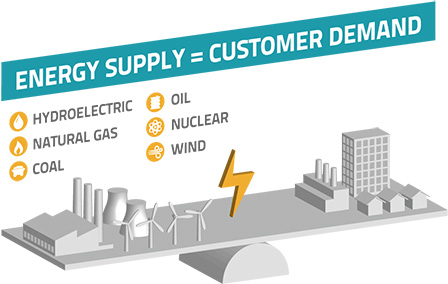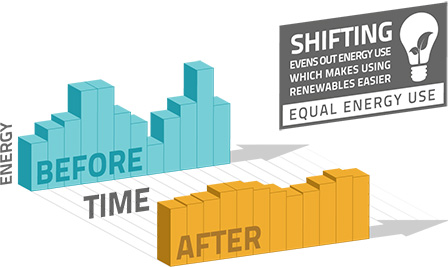OverView:
HOW THE POWERSHIFT
ATLANTIC SOLUTION WORKS
PowerShift Atlantic is a research project focused on finding more effective ways to integrate wind energy into our electricity system, with demonstration programs for residential and commercial customers underway across the Maritimes.
Our electric utilities strive to provide enough power generation to ensure Maritimers have electricity whenever they need it. Electricity in the Maritimes is produced through a combination of fuel sources including hydro, tidal, coal, oil, nuclear, natural gas and wind. Historically, the model for providing electricity has been based on generation following load – the electric utility forecasts customers’ need for energy and generates electricity to meet this demand. Customers consume power at their convenience; utilities ensure corresponding power is delivered through the grid. Now, PowerShift Atlantic is demonstrating a solution that aligns power supply more closely to when energy from renewable energy generation sources (like wind) is available – all in an effort to reduce our reliance on fossil fuel energy sources to meet customers’ need.

Wind is a valuable source of energy in the Maritimes – abundant, renewable and clean. The Maritime region has the potential to have the highest penetration of installed wind capacity in the country over the next 15 years. But wind-generated energy can’t be stored and there’s no way of adjusting weather patterns or wind production to meet customers’ energy demands.
Electric utilities in the Maritimes have heard their customers’ request for greener energy and are working to meet the challenge:
So how do utilities make the most of wind power, without asking customers to change their consumption or behaviour?
We can’t shift when the wind blows, but we can look at shifting when we use power to make more effective use of wind generation.


The solution does not, in any way, affect the supply of safe and reliable power. All equipment (or ‘end uses’) employed in this research has some kind of energy storage capability (for instance, water heaters, or commercial refrigeration units). By remotely managing the on, off, up and down times of these end uses – shifting cycles a few minutes here and there and combining loads from many customers – PowerShift Atlantic can demonstrate ways to optimize wind-generated energy, without requiring any change in customer behaviour or consumption.
Residential and Commercial electric customers play a key role in research: the solution starts inside homes and businesses. Intelligent components are installed on qualifying equipment (“end uses”). All eligible end uses (for instance, water heaters or commercial refrigeration units) have some kind of energy storage capability and do not rely on a constant supply of energy to function. This allows the utility to remotely shift the amount of energy delivered to that particular piece of equipment at precise times, without affecting its performance. Participating equipment continues to operate within desired temperature ranges.
The PowerShift Atlantic project uses many different hardware and software solutions, depending on the end use and systems already in place. Each end use component allows secure, two-way communication through existing, secure infrastructure – internet, cellular, or radio frequency.
The intelligent component on every participating end use is continuously communicating with an aggregator – a hardware/software combination that collects real-time information and combines end uses into groups, or “loads”. Customer participation is essential to success: for the aggregators to pool and assess loads meaningfully there must be a critical mass of participating end uses. The aggregators have the ability to shift energy use patterns intelligently and unnoticeably.
Forecast and actual load requirements are provided by the aggregators to a Virtual Power Plant. The Virtual Power Plant (VPP) is an intelligent energy management system. It works with the aggregators and the region’s system operator to direct the shifting of customer load. By smoothing the peaks and valleys of energy supply, and analyzing wind generation forecasts, the VPP informs the system operator of the amount of load that cannot be powered by wind power generation, and must be handled with conventional generation.
Two System Operators are involved in PowerShift Atlantic: New Brunswick System Operator and Nova Scotia Power System Operator. These two teams are responsible for assessing the electricity demands of their respective regions and sourcing reliable generation to meet the demand at all times. The end-to-end intelligence provided by the PowerShift Atlantic solution simplifies our system operators’ planning, improves power grid balance calculations, and allows the incorporation of more wind generation into the resource mix.
A key component of PowerShift Atlantic research is the application of improved wind forecast tools and technologies in development at the University of New Brunswick. The UNB research team is working closely with Environment Canada to automate statistical models of wind power forecasting and forecast uncertainties. Accurate wind power forecasting enables adding wind power to the grid with confidence.
PowerShift Atlantic is a multi-year initiative, launched in 2010 as one of 19 Clean Energy Fund projects currently underway nationwide. The development of software and hardware components is complete. Infrastructure is in place to implement the Virtual Power Plant and aggregators, install required equipment, perform intelligent load management, test end-to-end functionality and start measuring results. Residential and commercial customers across the region are connected, participating and engaged in a truly innovative and valuable way. The research project has been attracting attention as well as awards: the Canadian Electricity Association Sustainable Electricity award for Economic Excellence and the CanWEA R.J. Templin Award for its work in significantly advancing the wind energy industry in Canada. We look forward to collecting at least a full year of data that demonstrates viable ways to use more of our region’s installed wind capacity, work together with customers towards a greener grid, and reduce our reliance on fossil fuels.
PowerShift Atlantic is a research and demonstration project focused on finding more effective ways to integrate wind energy into our electricity system, with demonstration programs for residential and commercial customers across the Maritimes. As the demonstration period has now ended, and the program is completed, some of the information found on this site is no longer current. Our report summarizing the program’s results and findings can be found in the following
Project Completion Report
PowerShift Atlantic presents an opportunity to make a positive difference for the region and the environment. It is a chance for all of us to play a role in advancing the adoption of clean renewable energy sources and help create a better legacy for future generations of Maritimers.
